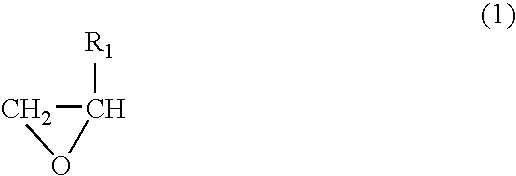Process for production of ethylene oxide copolymer
a technology of ethylene oxide and copolymer, which is applied in the direction of pipe supports, pipe/joints/fittings, mechanical equipment, etc., can solve the problems of not being able to achieve the melting point of ethylene oxide, the molecular weight of the polymer has not yet been achieved, and the melting point itself of the polymer is extremely difficult to control, etc., to achieve the desired melting point, easy to produce, and good productivity
- Summary
- Abstract
- Description
- Claims
- Application Information
AI Technical Summary
Benefits of technology
Problems solved by technology
Method used
Image
Examples
referential example 1
[0105] A reactor of 1 L, as equipped with max-blending blades (produced by Sumitomo Heavy Machine Industries, Ltd.) and an addition inlet, was washed with a solvent (toluene) and then heat-dried, and then internal air of the reactor was displaced with nitrogen. Into this reactor, there were charged 286.5 parts of toluene (having been subjected to the dehydration treatment with the molecular sieve) and 0.55 part of potassium t-butoxide (20 wt % tetrahydrofuran solution) (as a reaction initiator) in that order. After this charging, internal air of the reactor was displaced with nitrogen. The pressure was increased with nitrogen until the internal pressure of the reactor became 0.3 MPa. The temperature was raised with an oil bath under stirring by rotating the max-blending blades at 130 rpm.
[0106] After it had been confirmed that the internal temperature of the reactor had become 90° C., ethylene oxide and a monomer mixture of butylene oxide and allyl glycidyl ether (having been subje...
example 1
[0109] A reaction mixture containing a polymer of 125,000 in weight-average molecular weight Mw was obtained by carrying out a polymerization reaction in the same way as of Referential Example 1 except that the conditions for supplying the monomer mixture of butylene oxide and allyl glycidyl ether were changed as follows:
[0110]>:
[0111] After 15 minutes from the beginning of the supply of the ethylene oxide, the monomer mixture of butylene oxide and allyl glycidyl ether (butylene oxide / allyl glycidyl ether=17 parts / 14.5 parts) began to be supplied at a supply rate of 7 parts / h and was rationed for 2.25 hours since then. Since after 2.5 hours from the beginning of the supply of the ethylene oxide, the monomer mixture was rationed at a supply rate of 3.15 parts / h for another 5 hours (supply amount of the ethylene oxide: total 255 parts, supply amount of the monomer mixture: total 31.5 parts).
example 2
[0112] A reaction mixture containing a polymer of 106,000 in weight-average molecular weight Mw was obtained by carrying out a polymerization reaction in the same way as of Referential Example 1 except that the conditions for supplying the monomer mixture of butylene oxide and allyl glycidyl ether were changed as follows:
[0113]>:
[0114] After 30 minutes from the beginning of the supply of the ethylene oxide, the monomer mixture of butylene oxide and allyl glycidyl ether (butylene oxide / allyl glycidyl ether=17 parts / 14.5 parts) began to be supplied at a supply rate of 7.9 parts / h and was rationed for 2 hours since then. Since after 2.5 hours from the beginning of the supply of the ethylene oxide, the monomer mixture was rationed at a supply rate of 3.15 parts / h for another 5 hours (supply amount of the ethylene oxide: total 255 parts, supply amount of the monomer mixture: total 31.5 parts).
PUM
| Property | Measurement | Unit |
|---|---|---|
| elongational viscosity | aaaaa | aaaaa |
| melting point | aaaaa | aaaaa |
| viscosity | aaaaa | aaaaa |
Abstract
Description
Claims
Application Information
 Login to View More
Login to View More - R&D
- Intellectual Property
- Life Sciences
- Materials
- Tech Scout
- Unparalleled Data Quality
- Higher Quality Content
- 60% Fewer Hallucinations
Browse by: Latest US Patents, China's latest patents, Technical Efficacy Thesaurus, Application Domain, Technology Topic, Popular Technical Reports.
© 2025 PatSnap. All rights reserved.Legal|Privacy policy|Modern Slavery Act Transparency Statement|Sitemap|About US| Contact US: help@patsnap.com

